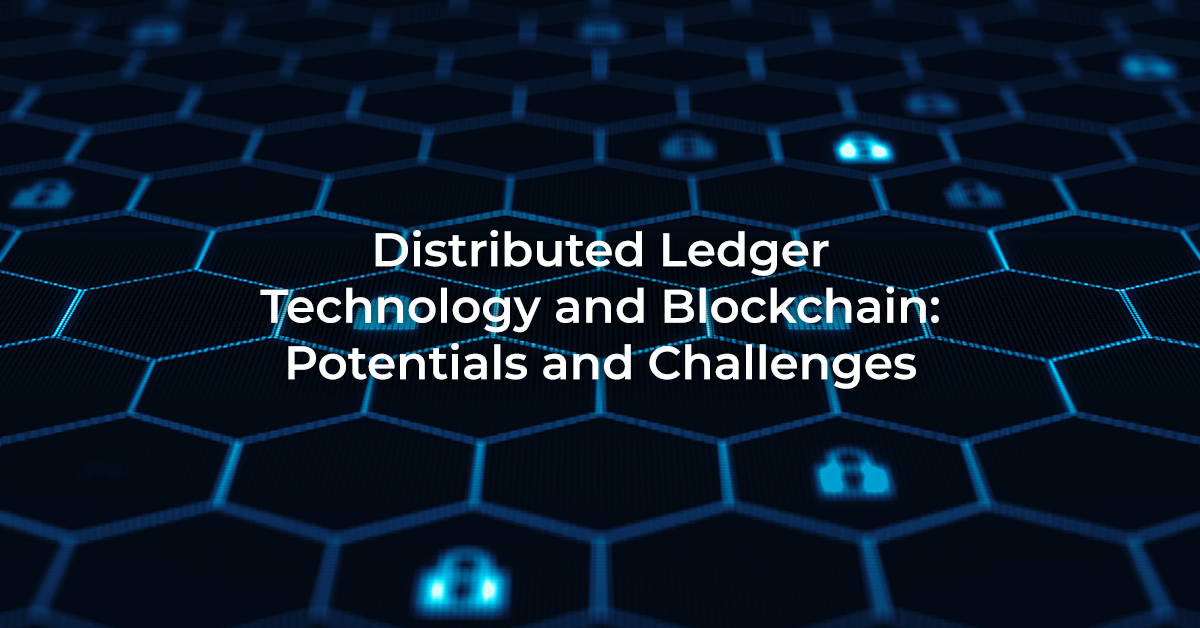
Distributed Ledger Technology and Blockchain: Potentials and Challenges
Distributed Ledger Technology (DLT) is a new method of data validation that does not require a trusted authority and it enables to record, share and synchronize data across a distributed network of data stores and participants in a transparent way.
Distributed ledgers (DLs) simply refer to a particular implementation of a larger category of shared ledgers which are basically the shared documentation of data across multiple and various parties. A shared ledger can either be a one single ledger that has layered permissions or be a distributed one which has more than one ledgers that are kept by a distributed network of nodes (network of computers). DLs are classified as ‘permissioned’ or ‘permissionless’ based on the criterion if the nodes (network participants) need to acquire permission to make alterations in the ledger. Another categorization is on the ‘public’ and ‘private’ ledgers which refer to the access to the ledgers by anyone or solely by the participating nodes within the network.
Blockchain can be defined as a specific data structure of some distributed ledgers that stores and transfers data in packages of “blocks” and those blocks are attached to each other in a digital “chain”. Blockchains utilize the cryptographic and algorithmic ways in logging and synchronizing data across a network but one of the prominent feature of this system is that it works in an immutable manner, namely, what is employed & encrypted within a blockchain cannot be deleted or changed.
Distributed Ledger Technology (DLT) and the blockchain technology are closely related because the latter mainly depends on the former in such a way that the transactions validated by miners (specific nodes in the network) who are committed for the verification, authorization and documentation of transactions are kept by the ledgers and all the participants within the network can access a copy of a unique ledger. This highlights another feature of blockchain system, which is decentralization, as opposed to traditional centralized transaction systems.
Although, blockchain can be simplified as the technology behind the cryptocurrencies, its benefits or capabilities can be useful for different areas in the world of finance such as cross-border transactions, smart contracts and trade finance, clearing and settlement systems, digital identity verification (therefore digital onboarding) and credit reporting. On the other hand, the technology of blockchain is still approached with some hesitations due to the lack of maturity. It faces challenges both in terms of the technology itself and the regulatory compliance issues.
Benefits of DTL and blockchain technology for financial services
The basic features of immutability and decentralization of blockchain technology promise safer and easier transactions while it helps establish a mutual trust in between trading parties. The technology also offers quick identification of individuals via its digital IDs and optimization of the financial services both in terms of time, cost and security. Among all the alternative and beneficial uses of blockchain technology in financial applications, the facilitation in the process of cross-border transactions is standing out.
Below, the five most useful applications of blockchain technology in the financial services are listed:
- Erasing inefficiencies and restrictions in cross-border transactions: Money transfer across borders is currently facing issues related to fees and time. Lacking a central clearing system, the cross-border payments are conducted via the network of different correspondent banks and therefore, the transactions have to go through different charging points (sending, receiving and in-between institutions) and time-wise, they are restricted to the working hours of the correspondent banks. The solution provided by the blockchain at this point is improving the whole process and experience by making it faster, more precise, and more cost-efficient. It replaces the correspondent baking network with the distributed network of DLT and eradicates the inefficiencies.
- Leveraging “Smart Contracts” and trade finance: The other financial application in which blockchain is used is the trade finance. The financial institutions have started to incorporate blockchain trade finance platforms in the creation process of the “Smart Contracts” in which the contract terms are applied in a computer language and in cases of related conditions are fulfilled, the terms are able to execute themselves. This system increases efficiency in high volumes and transparency at the same time.
- Making Clearing and settlements procedures redundant: As the data and transaction recording is highly accurate within blockchain system, it is probable that in the future, the whole clearing and settlement processes may become unnecessary which automatically means better efficiency for financial institutions with smaller costs and faster operations.
- Increasing security with digital identity authentication: Blockchain-enabled IDs are expected to ameliorate the security and trust issues within financial industry as it provides protection against fraud and velocity in the ID authentication processes.
- Improving credit reports: As traditional server-based credit reporting is prone to data breaches, the blockchain-based credit reporting offers a more secure reporting while at the same time in the credit score calculation process, it allows institutions to untraditional aspects into consideration.
Challenges of the DLT and blockchain technology and regulatory compliance
The anticipated and proven benefits of the DLT and blockchain technology are listed above. However, on the other side of the picture, there are technological and legal issues that still require solution. While the advantages of the DLT applications remain unclear at some points, the challenges associated with the migration of current financial infrastructure to DLT and the regulatory compliance are yet to be resolved.
The most notified challenges can be split and categorized into two: technological and regulatory challenges.
- Technological challenges:
- Immaturity of the technology: Distributed ledger and blockchain technologies are still at the early stages of development, that is why the validity and flexibility of the system remains as a concern for now.
- The question of permissionless distributed ledgers: In terms of transaction volume and speed, the permissionless distributed ledgers raises issues about the scalability of blockchains.
- Cooperative and integrated approach: In order for the DLT to be used for the financial services, different DLT systems will be required to work as interoperable and they need to be integrated with the existing systems.
- Technical vulnerabilities related to security: Cybersecurity is an issue for blockchain technology too since there are hardly any software that are fully resistant to the technical vulnerabilities.
- Decentralized nature of the system: The lack of a centralized infrastructure and entity to manage the system give birth to concerns related to the governance.
- Regulatory Challenges:
- KYC, CDD and AML compliance: DLT systems need to ensure a full compliance with Know Your Customer (KYC) and Customer Due Diligence (CDD) requirements within the framework of Anti-Money Laundering (AML) regulations in order to be adopted fully in the financial ecosystem.
- Lack of legal frameworks for regulatory vetting of DLT: Although regulators are studying the DLT and blockchain technology, the vetting and industry standards of the technology are still to be studied and developed.
Future is bright
Distributed Ledger Technology (DLT) and blockchain may still be at the early stages to be fully applied to the financial services and the challenges connected to the technology and the compliance are to be addressed and resolved first. However, there is a rising tendency to believe that the DLT applications in the finance industry are to gain acceleration especially in the areas that currently use manual interference and need higher automation to increase the efficiency.
Ahmet Vefik Dincer, CEO

